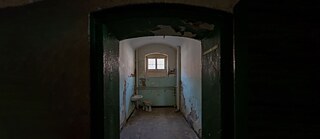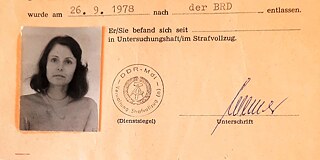German-German history
Negotiations in the shadows

From the early 1960s to the end of the 1980s, thousands of GDR prisoners were ransomed by the Federal Republic of Germany (FRG). It was a deal that benefited both sides. But how did the process work? An article on a unique aspect of German-German history.
In the novel Das Jahr ohne Sommer (The Year Without a Summer), a young girl asks herself: “Who buys imprisoned people?”. In this case, the incarcerated people were her parents, who were imprisoned for a year and a half in various GDR penitentiaries and then ransomed by the Federal Republic. As a child, Constanze Neumann could not explain the ransom of political prisoners. The adult Constanze Neumann, who is now a writer, could. She wrote an autobiographical novel about her life between her old home in the GDR and her new home in the Federal Republic of Germany. But the imprisonment and release of her parents still haunt her to this day.
An open secret
The fate of Neumann's parents is not an isolated case. 33,755 GDR citizens were ransomed from the totalitarian state by the Federal Republic of Germany. “This trade was an open secret”, says historian Jan-Phillip Wölbern, who wrote his doctoral thesis on the subject. Wölbern, who is now deputy head of the Konrad Adenauer Foundation's foreign office in Ukraine, explains that there were several factors that led East Berlin and Bonn to consider a ransom in the first place. Both the Federal Republic and the GDR regime were interested in the deal, although their interests differed greatly. The FRG had a humanitarian interest, the GDR acted out of material interest.Certain lawyers played a decisive role in the proceedings, acting as border crossers and catalysing the ransom. The resourceful lawyers mediated between the governments. At the latest when the Wall was built, the Federal Republic realised that the GDR regime would remain in place for a long time. A political reorientation was therefore necessary. “There was no master plan”, says the historian. Neither the Federal Republic nor the GDR had any experience with the release of political prisoners. Both states first had to find out under what conditions they wanted to enter into this trade. The Federal Foundation for the Reappraisal of the SED Dictatorship says: “The GDR was never stingy in its criticism of the capitalist pursuit of profit; it presented itself as the antithesis of the economised Federal Republic.” However, the foundation also adds: “Less squeamish was the treatment of political prisoners. They were given a price tag and sold to the Federal Republic. First for 40,000, later for 90,000 marks.” One of the political prisoners was Constanze Neumann's mother, Eva-Maria Neumann. The contemporary witness wrote about her traumatic experiences in her book Sie nahmen mir nicht nur die Freiheit – Die Geschichte einer gescheiterten Republikflucht (They didn't just take my freedom - the story of a failed escape from the GDR). As a young woman, she made several escape attempts with her husband and young daughter. The last one landed Neumann in prison. During the arrest, her daughter was torn from her arms and placed in a children's home for several days. The girl was then placed in the care of her grandparents in the GDR. This was a traumatic experience for Eva-Maria Neumann, which she can now talk about after almost 30 years. “It was the worst thing that ever happened to me”, she states.
After her conviction for attempting to flee the republic, Neumann was taken in a cattle car to Stollberg in Saxony to the GDR's most notorious prison, the women's prison. There she began a time full of fear, sleep deprivation and illness. Whilst in prison, she learnt of the possibility of being released by the Federal Republic of Germany. A glimmer of hope in hopeless times. “There was actually always a transport in Hoheneck, albeit at irregular intervals”, Eva-Maria Neumann remembers. A beam of light from a building at night showed the inmates when a transport from the prison was being prepared for a prisoner release.
List with names
According to Wölbern, the name on the correct list decided who was allowed to go to freedom. People whose names did not make it onto the list were released to their old lives in the self-proclaimed workers’ and peasants’ state after their time in prison. Only political prisoners, such as fugitives from the republic, had a chance of being released. Relatives, friends or acquaintances in the West were instructed to hire lawyers to represent the prisoners. This was also the case for Eva-Maria Neumann. The lawyers handed over the list of names to the GDR authorities, who decided who could be ransomed and who could not, explains the expert

“The ransom deal between the two states was a state secret”, says Wölbern. But Western media such as the Bild newspaper and Die Welt reported on the free purchases. It was different in the totalitarian East. “There was no publicity and no free press there”, explains the historian. Only GDR citizens with the forbidden West German television had the chance to find out about the ransom.
For the ransomed women and men, liberation was a turning point in their lives. However, the past has left its mark on many of them – including Eva-Maria Neumann and her daughter Constanze. The Neumanns are still preoccupied with what happened today. The loss of their homeland, the imprisonment, the ransom and the new life in freedom - for each of the two women a challenge that had to be dealt with. Eva-Maria Neumann wrote down her experiences immediately after her release. “I wanted to record what happened for the family”, she says, “it really helped me to write about it.” Her daughter also decided to write about it. Both Eva-Maria Neumann’s eyewitness account and Constanze Neumann’s novel have been published by the renowned East German publishing house Aufbau Verlag. Both women have written about a subject that receives little public attention.
the cultural sector
There are several films, series or documentaries about the GDR, such as the Oscar-winning film Das Leben der Anderen (2006) (The Lives of Others) by Florian Henckel von Donnersmarck, which looks at life in the SED dictatorship from contrasting perspectives. Even Hollywood has been involved with the GDR. Steven Spielberg made the film Bridge of Spies (2017), the first and most historic exchange of agents during the Cold War: the swap of Soviet spy Colonel Rudolf Abel for US pilot Gary Powers. The film is set in East Berlin and shows a grey, brutal and totalitarian state.Films that often flirt with the phenomenon of ‘Ostalgie’ show a different perspective. Ostalgie is a neologism of the terms nostalgia and East. Go Trabi Go: Die Sachsen kommen (1991) by Peter Timm was one of the first films to take a comedic look at the East. The Ostalgie trend continued in Germany until the mid-2000s. One of the best-known films is Good Bye, Lenin! (2003) by Wolfgang Becker. Films such as Sonnenallee (1999) or NVA (2004) (National People's Army of the GDR) by Leander Haußmann also showed life in the GDR from a humorous perspective. Not without being criticised for trivialising life in the SED regime.
The release of GDR prisoners by the Federal Republic of Germany, on the other hand, has so far only been sparsely addressed in the cultural scene. The 2007 television film Die Frau vom Checkpoint Charlie by Miguel Alexandre deals with the trade, at least in passing. “Buying freedom was not a mass phenomenon”, says Wölbern. Measured against the population of the GDR from the early 1960s to the end of the 1980s, which totalled around 17 million people, the 33,755 people who were bought out were a small number. This may be one of the reasons why the freedom purchase has only been marginally discussed in the cultural sector. “However, the freedom purchase provides enough material”, says Wölbern, who wonders why this unique aspect of German-German history has not yet been given the big stage.